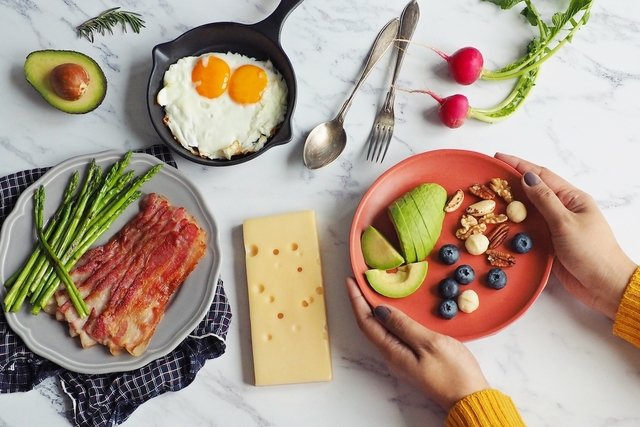Keto Diet What to Eat What Not to Eat
The ketogenic diet consists of a drastic reduction in the intake of carbohydrates. For this reason one should avoid eating bread and rice, opting for the consumption of lean meats and fats. As long as this diet is supervised by a nutritionist, it can be a good alternative for those who wish to lose weight, as the body starts using its own fat stores as a source of energy instead of the carbohydrates that come from food.
This diet is especially known for helping to control and prevent epileptic seizures. However, it is also being researched as an anti-cancer treatment as cancer cells feed off carbohydrates, which is the food group the ketogenic diet does not include.
It is important for the diet to be done only under the supervision and guidance of a nutritionist. This is so that you can have a complete nutritional assessment to find out whether you can do the diet.

How Does the Keto Diet Works
The ketogenic diet comprises a drastic reduction of carbohydrates, which will make up only 10 to 15% of total daily calories. However, this quantity may vary according to your health condition, how long the diet will last, and your dietary goals.
To compensate for the reduction in carbohydrates, you will need to up your intake of fat significantly. This means eating foods such as avocado, coconut, seeds, cream, olive oil, peanuts, chestnuts, walnuts, and almonds. The quantity of protein in your diet should also increase until it comprises 20% of daily calories. It is, therefore, necessary that you eat meat, chicken, or fish at lunch and dinner and that you have eggs and cheese for snacks.
When you start this diet, your body will go through an adaptation period which can last from several days to a few weeks and it happens because your body switches to producing energy through fat, instead of carbohydrates. So it is possible that in the first days you will have symptoms such as exhaustion, lethargy, and headaches. These will disappear though, once the body has adapted.
Another similar diet to the keto diet is the low-carb diet, the major difference being that in the keto diet there is a much higher restriction of carbohydrates.
"Keto Foods" And Foods To Avoid
The following table lists the foods that are allowed in the keto diet and the ones that are forbidden.
| Keto Foods/ Allowed | Foods To Avoid |
|---|---|
| Red meat, chicken, eggs, and fish | Rice, pasta, corn, cereal, oats, and cornstarch |
| Olive oil, coconut oil, butter, pork fat | Beans, soy, peas, lentils, and chickpeas |
| Cream, cheese, coconut milk, and almond milk | Wheat flour, bread, toast, and most salty snacks |
| Peanuts, nuts, hazelnuts, Brazil nuts, almonds, peanut butter, almond butter | White potato, sweet potato, cassava, yam, parsnips |
| Fruit such as strawberries, raspberries, blackberries, olives, avocado or coconut | Cakes, desserts, biscuits, chocolate, candies, ice-cream, chocolate milk |
| Vegetables and greens, such as spinach, lettuce, broccoli, cucumber, onion, zucchini, cauliflower, asparagus, red chicory, white cabbage, Bok Choy, celery or bell pepper | Refined sugar, muscovado sugar |
| Flaxseeds, chia seeds, sunflower seeds | Chocolate powder, milk |
| Milk and alcoholic drinks |
In this type of diet, whenever you eat processed food it is very important to check the nutrition facts label to check if there are carbohydrates and in which quantity, so as not to exceed the daily quantity.
3-Day Keto Diet Plan
The following table contains an example of a three-day keto diet meal plan:
| Meal | Day 1 | Day 2 | Day 3 |
|---|---|---|---|
| Breakfast | Eggs fried in butter + mozzarella cheese | Omelette made with 2 eggs and vegetable filling + 1 cup of strawberry juice with 1 teaspoon of flaxseeds | Smoothie made with avocado, almond milk and ½ tablespoon of chia seeds |
| Morning snack | Almonds + 3 slices of avocado | Strawberry smoothie with coconut milk + 5 walnuts | 10 raspberries + 1 tablespoon of peanut butter |
| Lunch/ Dinner | Salmon with asparagus + avocado + olive oil | Vegetable salad with lettuce, onion and chicken + 5 cashew nuts + olive-oil + Parmesan cheese | Meatballs with courgette noodles and Parmesan cheese |
| Afternoon snack | 10 cashew nuts 2 tablespoons coconut chips + 10 strawberries | Eggs fried in butter + rennet cheese | Scrambled eggs with oregano and grated Parmesan |
It is important to remember that the keto diet should be prescribed by a nutritionist.
What Is a Cyclical Ketogenic Diet?
A cyclical ketogenic diet helps to maintain diet follow-through and good weight loss, as well as providing energy for physical exercise.
In this type of keto diet, you follow the keto diet meal plan for five consecutive days, and then you have two days when you can eat carbohydrates, such as bread, rice, and pasta. However, desserts, ice-creams, cakes, and other sugar-rich products should continue being off-limits.
Possible Side Effects
The ketogenic diet is not advised for those over 65, children and teenagers, and pregnant and breastfeeding women. It should also be avoided by those who have an increased risk of ketoacidosis, such as type 1 diabetics, uncontrolled type 2 diabetics, people with low weight, or with a history of liver or kidneys diseases and cardiovascular alterations, such as a stroke. It is also not recommended for those with bladder stones or anyone taking medications that contain cortisone.
In these cases, the ketogenic diet will need to be authorized by a doctor and followed-up by a nutritionist.
Keto Diet What to Eat What Not to Eat
Source: https://www.tuasaude.com/en/ketogenic-diet/